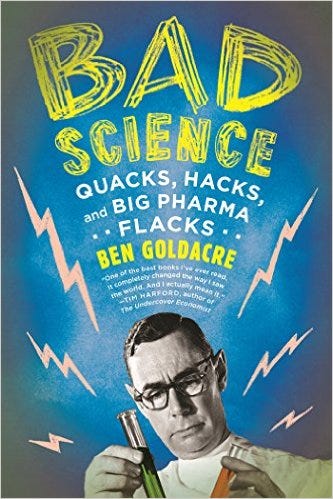Learn how the media and big pharma manipulate Science to represent their interests.

Bad science for profit
Companies make use of people’s ignorance or unwillingness to check the facts, to mislead them with bad science. Bad science is used to convince consumers to buy a product, for example, a beauty or nutrition product. Companies know that most people will just accept the results presented because the science is too complicated to understand, or so most people think.
One example of these types of frauds are the detox footbaths called Aqua Detox. Supposedly the bath cleanses your body of “toxins” painting the water in brown color. But what really happens is that the brown water is produced chemically by the iron from the electrodes when the device is turned on.
Sometimes these frauds cost many lives. Matthias Rath influenced the South African government to replace anti-HIV drugs and promote his vitamins which he claimed would reduce the risk of AIDS by 50%. He based his assertion on a distortion of a Harvard study involving a thousand HIV-infected Tanzanian woman. The study only showed that low-cost generic vitamins or a better diet could push back the start of anti-HIV drug regimens in some patients, but he claimed that the vitamins were a superior cure and that anti-HIV drugs worsened immune deficiencies. One study estimated that 343,000 deaths could have been prevented if the African government would have given out the anti-HIV drugs instead of the vitamins during that period.
Pharmaceutical companies often finance their own studies because public entities cannot afford to pay the high price, $500 on average. Those companies, interested in positive results so that they can sell their products. Positive trials are published more often than negative ones. In one case a drug company’s antidepressant SSRIs were no more efficient than placebo. Sometimes positive trials are published several times so thus inflating the apparent efficacy. Even if the drugs are efficient, they still can have side effects which are intentionally not mentioned by the researchers.
Trials need Placebo control
Placebo is the effect of an empty drug, like a sugar pill, which has a healing effect. Nobody knows why but they work, based on the patient’s feelings. The patient thinks he is being treated, which causes the results.
Studies have shown that four placebo pills work better than two, and an injection performs even better, for sure because it seems more dramatic. Even the color of a placebo pill can make a difference; pink color tends to make you feel motivated while blue ones relax you.
One study determined that in a narrowed arteries treatment the administered fancy-looking laser catheter was almost as effective as the real treatment.
Due to this effect, all drugs are compared to placebo, only if they have a bigger effect than placebo do they have an actual effect on their own. This is what it means to “placebo control” a study.
Trials need to be randomized
Trials define participants in two groups, the group which receives the treatment, and a group which receives placebo only. Later the results are compared to see if the treatment had an effect. But it turns out that more factors need to be taken into account to create a fair trial.
Trials need to randomize which participants were assigned to each group, the treatment or the non-treatment group. Unclear randomization can overstate the efficiency of treatment by 30+%. This is because participants called Heartsinks influence the results of a study. The definition of a heartsink patient is a recurring patient who cannot be definitively cured or whose condition is undiagnosable or untreatable or who reports nebulous symptoms, they “make a doctor’s heart sink in dread.”
All studies have to define the method of randomization they used to counteract the effect of individual participants.
Trials need Blinding
Not only participants need to have zero knowledge about the group they are participating in, but also the testers and doctors. Otherwise, they could have some impact on the results. To prevent that something called blinding is used. Blinding means that neither the participants nor the testers have knowledge about which participant receives the treatment and which receives the placebo.
Combined data often is more conclusive
Often the data of a single study leads to one result, but when more data is added for example through a meta-analysis of several studies, the result differs.
Why? Because patterns do not always emerge from a single study, often multiple studies have to be performed and combined so that conclusions can be drawn.
Delusions and biases
People often delude themselves. For example, we often have a bias to search for information which supports our beliefs and to find flaws in information which opposes them. This process is called cherry picking.
[For more information on cognitive biases check out this website.]
The media uses dumbed down and misinterpreted science to get clicks
The media wants more people to visit their sites and read or watch their news. To attract more readers the media often crafts catchy headlines based on bad or incomplete interpretations of scientific studies. People see those headlines, are attracted to them and consequently check them out. Headlines which allude fear do especially well, a meteorite which could destroy all life on earth in a spectacular fashion naturally attracts the attention of many people. Even if that meteorite orbits at a safe distance from earth.
Conclusion: Most of the science presented in the media is really just pseudo-science to catch people’s attention. The word science is used as authority bias so that people pay attention. People are more likely to pay attention if they are told science has found something, even if the study showed something completely different.
